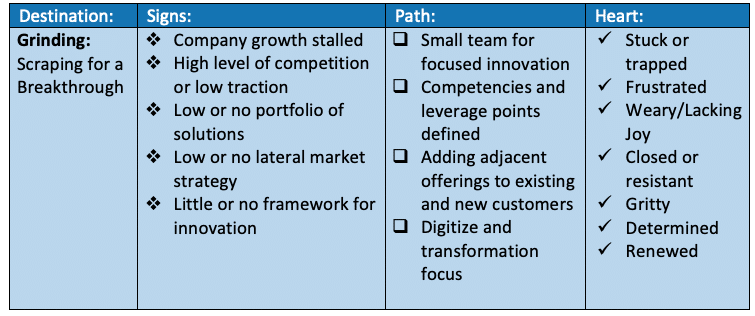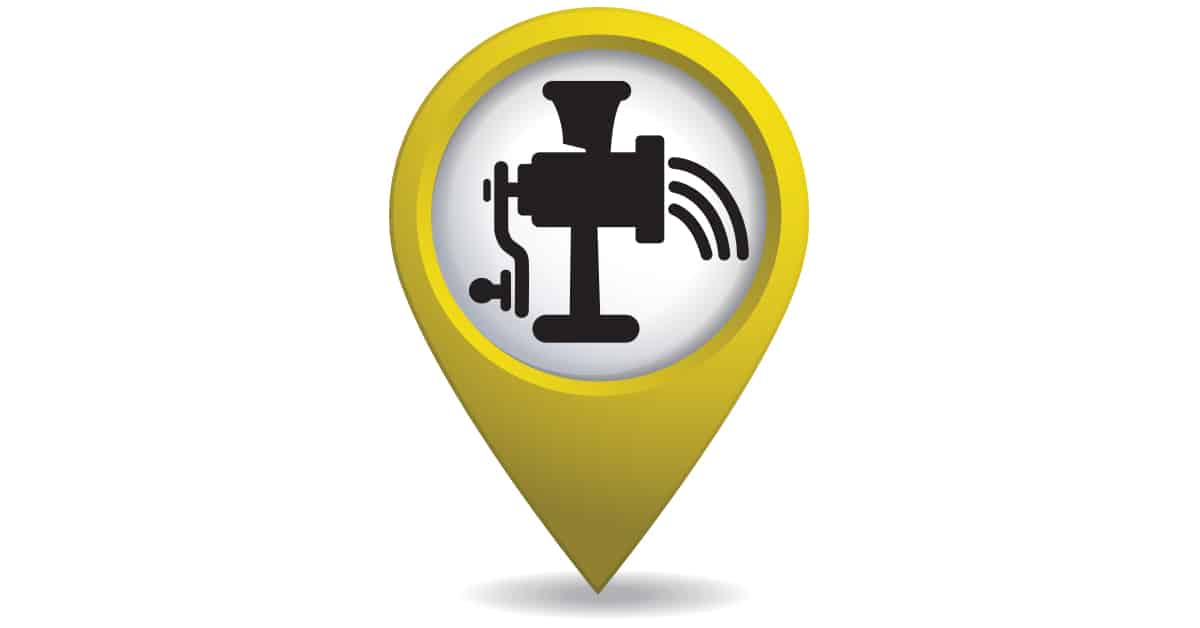How to move beyond simply trying harder
In our first blog, we introduced a new map to help identify where your company is and a path to more quickly get to where you want to go. By way of review, the map identified six destinations of companies from Start Up to Legacy. These six are: Planting, Drowning, Grinding, Scattering, Evolving, and Transcending.
The Grinding Stage is the third destination we are unfolding in more detail. As before, we will identify each destination’s signs, paths, obstacles, and states of heart. At a 30,000-foot view, below is what the destination of Grinding looks like:

Now, we will drill down into “Grinding” to help it come to life.
The Grinding Stage: The Signs and the Paths
The Grinding Stage is a destination most typically found in established companies. Ideas that started off fresh and exciting have now turned into routine. While routine is not a bad thing, it can lead to stagnation. Stagnation signals a lack of growth or development.
The adage, “If you are not growing, you are dying” is apt. Innovator and author George Land discussed the need for a “theory of transformation,” an evolving creative process in his book, Grow or Die, the Unifying Principle of Transformation.
There are numerous examples of companies that failed because they got “stuck”, stopped growing, and then died. Think of companies like Kodak, Xerox, or Blockbuster video that seemed too big to fail. Owners and employees that feel stuck and “grit their teeth” as they slog through the motions without improvement can become downright frustrated. Without improvement and renewal, the work slowly becomes a grind and can take the joy out of life.
Checking the Energy Level of your Company
Perhaps you feel that the burst of energy that built your business is fading. Instead of stepping back and exploring, your staff continues to operate in predictable patterns.
Getting the routine work done is important, but it can lull a company to sleep. You may be working hard, but you do not feel, or see forward movement. Like gears that start to wear, you can feel a grinding starting to take place. Some signs that your company is “grinding” include:
- A notable loss of interest from your consumer
- Seeing customers go elsewhere for efficiencies, and
- A state of “we have always done it this way” is prevalent, while Innovative ideas are rare
A Common Cycle:
How do companies get into the Grinding Stage? Businesses form because they have a new idea or product that starts off as novel. If it is good, competition floods in and the market starts to turn noisy. Unfortunately, if the value of the product or service does not continue to evolve, the market will look to others that offer the same goods, plus other pieces they need.
Without a constant feedback loop built into your process, your business can very quickly lose track of what customers and the market want. It is easy to get comfortable, and start to think that everything will continue as it started. This is rarely true in anything.
Business disruption, or momentous change within an industry can come from places you least expect it. COVID-19 created astonishing opportunities for new methods of providing products and services. During and since COVID we have seen online sales dramatically increase. Products began to be delivered in new ways, including drone deliveries.
Former CEO of General Electric and famous business speaker Jack Welch has said, “willingness to change is a strength” and encouraged leaders to “change before you have to.”
So, how do we move forward if we find ourselves “grinding”? It starts by understanding the obstacles.
Obstacle 1: Focus on the Day- to- Day
The first obstacle often seen in the Grinding Stage is the Heads Down Trap. While we are creatures of habit, we can easily fall into ruts. We may ignore feelings of complacency and be unlikely to admit we’re stuck in the past. We can be closed off or resistant to new ways of thinking. If care is not taken, a company can find itself in a “heads down” trap.
One technology company we worked with found themselves caught in the day-to-day. The team was focused on operational excellence. Having operational excellence is a good trait, however, they had few mechanisms to get feedback from the market or to get information from their customers to help them solve other business issues.
The company had a strong offering when it originally came to market, but now was surrounded by companies that had the same offering and claimed the same attributes. Innovation was not part of their strategy.
We helped this company by identifying the lack of innovation focus and competency. The next step was to create a small team that began to focus time to innovation, both through talking with customers, and focusing on desired customers. By interviewing and talking with both these constituencies, they began to find new ways to combine both products and services to gain new traction in the market. The impact both in current sales and pipeline was significant.
Head Down Trap Symptoms:
How can you tell if your business has entered this Head Down trap? Staff has become so immersed on the day’s operations, that there is no attempt to look up and outward to examine and understand market shifts or trends that will affect the business down the road.
Obstacle 2: No Feedback loop
Being in the Grinding Stage can lead to hearts filled with frustration. Many people first get into business because they like the field they are in, and they are really good at what they do. Often, they enjoy the technical side of things— and shy away from being out in the market, talking to customers, and looking across industries. The market environment often changes, and because they do not have a feedback loop, they instead become disappointed, and annoyed, because what worked before is not working now.
We helped one environmental business positively transform from being stuck in grinding. The company has great reviews from their customers and an outstanding reputation. They had determined to bring on a new product, based on the environmental changes taking place. The primary audience for their main product seemed to be a good candidate, but they were not seeing traction. This new initiative turned into grinding, with little results.
We helped by creating a small team, brought in from outside, to bring a new perspective. The goal was to examine the target markets and engage in pertinent conversations. This team discovered the true audience for the product was not their current level of contact within their customer base. Instead, the audience was not only at a different level, but had a different criteria for decision making. This product launch is now a “foot in the door” that will allow the company to expand into conservation and other services that drive a return for multi-family owners.
Feedback loop Symptoms:
No team or group has been organized to focus on new client needs, feedback, or innovation. There is a lack of knowledge of the market, plus not much value placed on creativity, and development of additional products or services. Business is stagnant.
Obstacles 3: The Identity Trap
A third obstacles seen in the Grinding Stage is the Identity Trap. Sometimes we forget why we started something and what excited us about it. Reflecting on the “why” can help us look at new ways to look at the “what” or “how.” Revisiting the mission and vision of a business may spark discussion on the realities of its performance, the current market and overall company environment. What is working? What is not working? Why or why not are we on track with goals? Some goal-setting and/or strategic planning would spark excitement and turn the weary heart into one that is filled with joy.
A hosting service company was not seeing the growth it desired and expected. The owner asked us how he could become an “owner,” rather than an “operator/owner.” Building a staff had become an enormous struggle.
An analysis revealed that employees felt too reliant on the owner. They did not feel empowered enough to make simple changes or offer any new ideas. Staff was becoming increasingly frustrated while waiting for approval on each step. This resulted in a significant turnover as it became more and more apparent that the owner was not only resistant to change, but was truly not open to giving up control. Both the staff and owner had grown weary and disappointed in a lack of growth or innovation mindset.
It is common for founders and owners to “become” the business. In these cases, it takes time for a realization to take place that to see change, “I must change.” Often, it is having circumstances reoccur creating frustration or for an external change that allow this shift to take place in the heart of the leader. In this case, an outward circumstance helped the owner to rethink his long term direction.
Identity Trap Symptoms:
Staff is reluctant to collaborate and work together toward the mission and objectives. There is not an effective team effort. Owners are reluctant to change and hear different perspectives. Certain staff are “wearing capes” – being the hero and often not letting others help. This can cause other team members to feel disrespected, and that their skills or input is not valued.
Obstacle 4: That is the way we always have done it
A fourth obstacle encountered in the Grinding Stage can come from the Entrenchment Trap. Many employees have grown up in their roles and responsibilities and have become set on the way things work. Their mantra is “if it’s not broken, don’t fix it.” While this sounds like good common sense, it can lead to an environment where creativity, modernization, or ingenuity can stagnate.
Another business we guided was operationally excellent, but did not experience the growth it hoped for. We found out staff was operating not only without a market research plan, but without a product road map. At the heart of the challenge was the lack of a feedback function or mechanism. The company had become very technically sound, but had lost the focus understanding business problems as a path to delivering solutions. Employees and the owner found it very hard to move to new ideas and felt disappointment and weariness. The Grinding destination was taking its toll.
The solution was multi-pronged. The first step was to focus the team on engaging with customers in a new way. The focus became understanding their customer’s business problem to look for areas they could solve that would leverage their competencies. The second was to reward staff for bringing forward innovative ideas and enabling them to implement their suggestions. This gave staff a sense of empowerment and excitement as they shared their ingenuity and suggestions for improvement to the company. The third was to create a team that focused on taking the information, formulating business cases, and doing the market research to determine viability. The result was to create a new strategic focus that has provided new growth.
Entrenchment Trap Symptoms:
How do you know you are stuck in this entrenchment trap? When you do not offer staff any outlet or support system. Eventually the desire of employees to offer new ideas, ingenuity, or inspiration stalls or even feels prohibited. There appears to be no one or nowhere to offer different methods of solving problems. There is frustration in doing the same thing over and over again, while hoping for better results.
Impacts of the Obstacles and Traps of Grinding Stage
Look out for these red flags:
- Customer retention becomes harder and there is not a clear reason why.
- New sales are flat or dropping, and there is not an understanding of market changes.
- Price compression/margin compression is happening as the cost of developing a product or service rises faster than the sales price. A profit margin is sure to decline over time.
- There is a turnover of staff, stemming from frustration.
Paths to move from idea to results:
- Innovation Team: Let the main company focus on “the good work,” while a small group focuses on market feedback, ideas, and innovation. Staff will feel encouraged to collaborate and find creative solutions.
- Understand your core competencies and leverage them in adjacent spaces: One way is to use what you are best at…in different ways…so you can open new value and markets.
- Bring more products or services into your portfolio that complement who you are, and what you do. This path will create more opportunity to service existing customers, and also becomes a “foot in the door” for new customers.
- Digitize for new value, customer experience, and efficiencies: Modernization packages your strengths, creates a new way to deliver, can delight customers, and leverage strengths.
“Grinding” Stage Success:
Scraping for a breakthrough is difficult. It can be especially hard when staff becomes increasingly frustrated due to feeling stuck, trapped, or have become resistant to new ideas. You want to break away from this destination or it will lead to declines that can turn into the end of your business over time.
If you find your company in the Grinding Stage, leverage the determination and grit of your company. A key to doing that effectively is finding the right path or strategic plan so that growth and renewal will reverse stagnation. Be sure to create an outlet for new ideas and to create a permanent market feedback loop.
It is important to reflect and revisit the “why we do what we do” in your mission and vision. You’ll feel joy again in owning your business, and in the process, refresh your staff, as well.
Where there is no counsel, purposes are frustrated,
but with many counselors they are accomplished.
Proverbs 15:22
“Change is inevitable. Growth is optional.”
John C. Maxwell
“To improve is to change; to be perfect is to change often.”
Winston Churchill




0 Comments